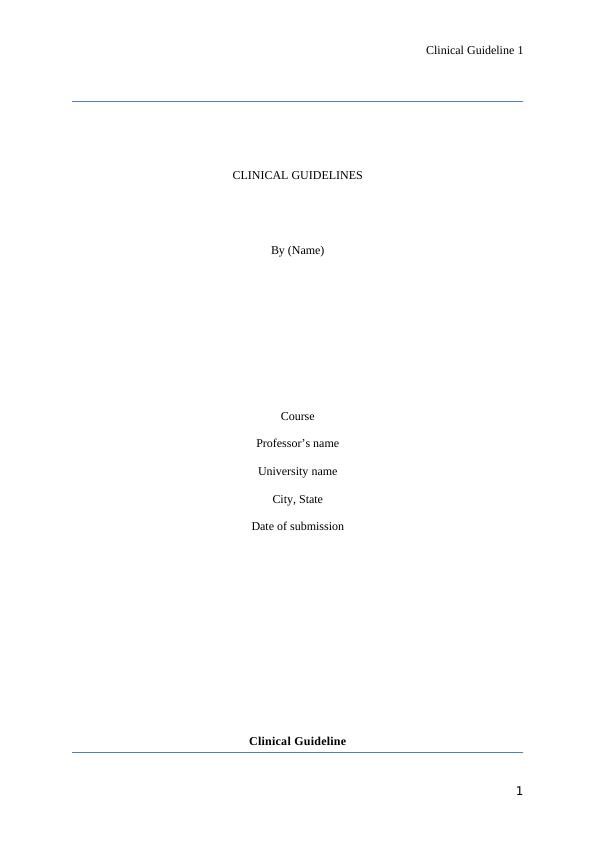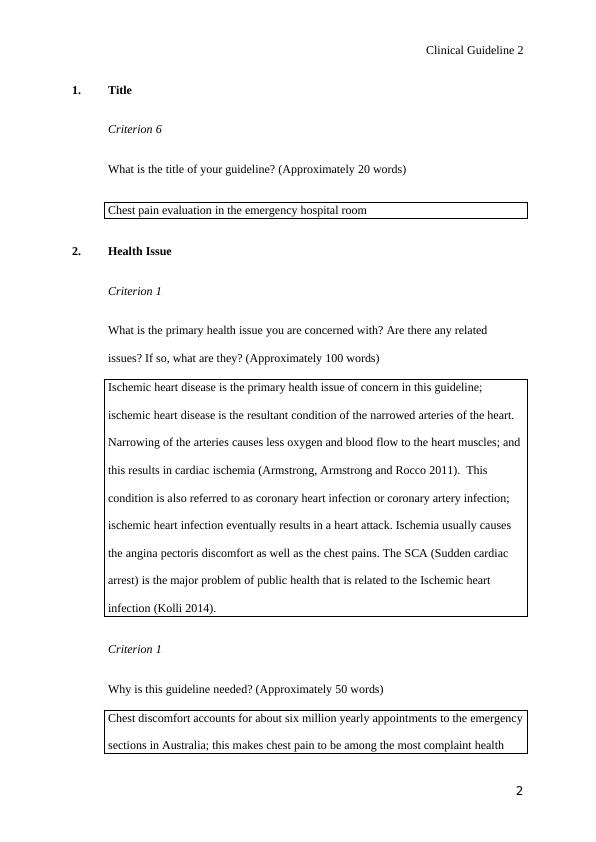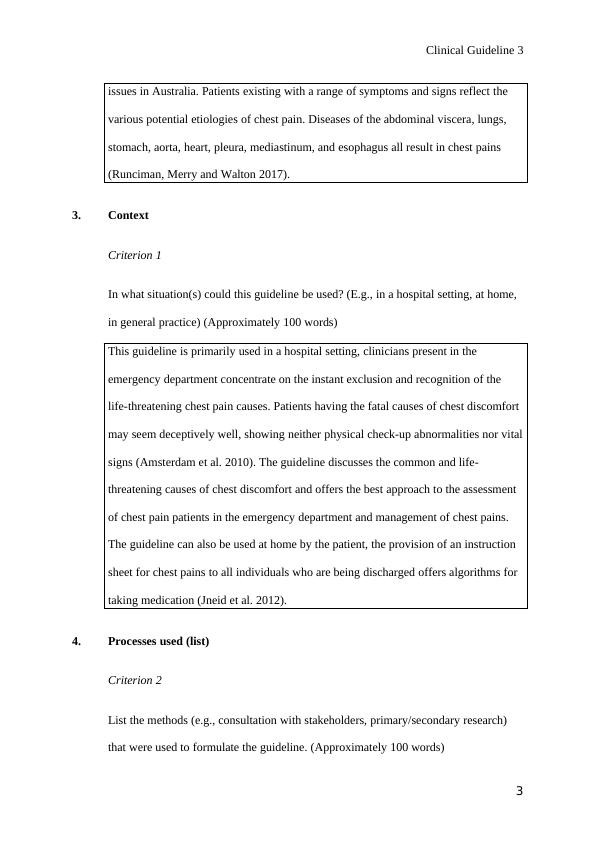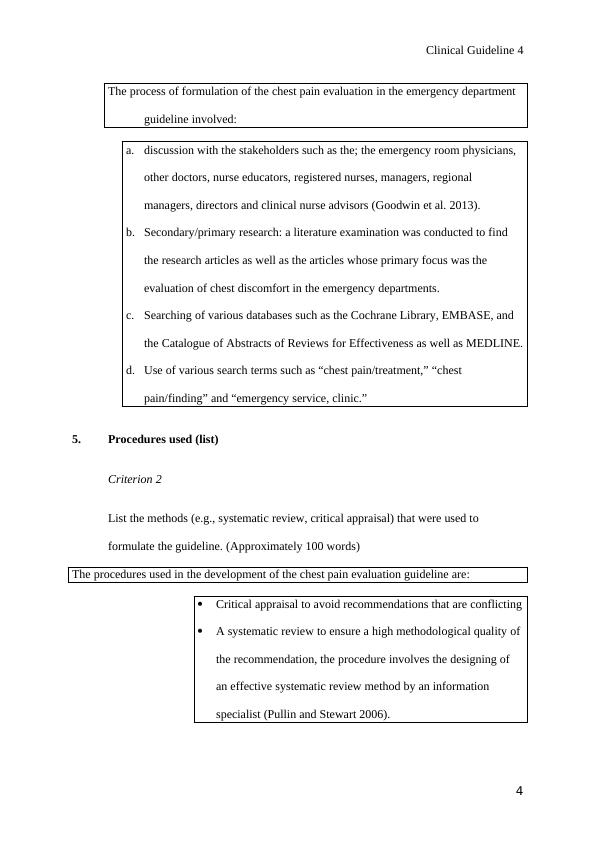Assignment on Clinical Guideline
Added on 2021-06-15
13 Pages2958 Words18 Views
Clinical Guideline 1
CLINICAL GUIDELINES
By (Name)
Course
Professor’s name
University name
City, State
Date of submission
Clinical Guideline
1
CLINICAL GUIDELINES
By (Name)
Course
Professor’s name
University name
City, State
Date of submission
Clinical Guideline
1

Clinical Guideline 2
1. Title
Criterion 6
What is the title of your guideline? (Approximately 20 words)
Chest pain evaluation in the emergency hospital room
2. Health Issue
Criterion 1
What is the primary health issue you are concerned with? Are there any related
issues? If so, what are they? (Approximately 100 words)
Ischemic heart disease is the primary health issue of concern in this guideline;
ischemic heart disease is the resultant condition of the narrowed arteries of the heart.
Narrowing of the arteries causes less oxygen and blood flow to the heart muscles; and
this results in cardiac ischemia (Armstrong, Armstrong and Rocco 2011). This
condition is also referred to as coronary heart infection or coronary artery infection;
ischemic heart infection eventually results in a heart attack. Ischemia usually causes
the angina pectoris discomfort as well as the chest pains. The SCA (Sudden cardiac
arrest) is the major problem of public health that is related to the Ischemic heart
infection (Kolli 2014).
Criterion 1
Why is this guideline needed? (Approximately 50 words)
Chest discomfort accounts for about six million yearly appointments to the emergency
sections in Australia; this makes chest pain to be among the most complaint health
2
1. Title
Criterion 6
What is the title of your guideline? (Approximately 20 words)
Chest pain evaluation in the emergency hospital room
2. Health Issue
Criterion 1
What is the primary health issue you are concerned with? Are there any related
issues? If so, what are they? (Approximately 100 words)
Ischemic heart disease is the primary health issue of concern in this guideline;
ischemic heart disease is the resultant condition of the narrowed arteries of the heart.
Narrowing of the arteries causes less oxygen and blood flow to the heart muscles; and
this results in cardiac ischemia (Armstrong, Armstrong and Rocco 2011). This
condition is also referred to as coronary heart infection or coronary artery infection;
ischemic heart infection eventually results in a heart attack. Ischemia usually causes
the angina pectoris discomfort as well as the chest pains. The SCA (Sudden cardiac
arrest) is the major problem of public health that is related to the Ischemic heart
infection (Kolli 2014).
Criterion 1
Why is this guideline needed? (Approximately 50 words)
Chest discomfort accounts for about six million yearly appointments to the emergency
sections in Australia; this makes chest pain to be among the most complaint health
2

Clinical Guideline 3
issues in Australia. Patients existing with a range of symptoms and signs reflect the
various potential etiologies of chest pain. Diseases of the abdominal viscera, lungs,
stomach, aorta, heart, pleura, mediastinum, and esophagus all result in chest pains
(Runciman, Merry and Walton 2017).
3. Context
Criterion 1
In what situation(s) could this guideline be used? (E.g., in a hospital setting, at home,
in general practice) (Approximately 100 words)
This guideline is primarily used in a hospital setting, clinicians present in the
emergency department concentrate on the instant exclusion and recognition of the
life-threatening chest pain causes. Patients having the fatal causes of chest discomfort
may seem deceptively well, showing neither physical check-up abnormalities nor vital
signs (Amsterdam et al. 2010). The guideline discusses the common and life-
threatening causes of chest discomfort and offers the best approach to the assessment
of chest pain patients in the emergency department and management of chest pains.
The guideline can also be used at home by the patient, the provision of an instruction
sheet for chest pains to all individuals who are being discharged offers algorithms for
taking medication (Jneid et al. 2012).
4. Processes used (list)
Criterion 2
List the methods (e.g., consultation with stakeholders, primary/secondary research)
that were used to formulate the guideline. (Approximately 100 words)
3
issues in Australia. Patients existing with a range of symptoms and signs reflect the
various potential etiologies of chest pain. Diseases of the abdominal viscera, lungs,
stomach, aorta, heart, pleura, mediastinum, and esophagus all result in chest pains
(Runciman, Merry and Walton 2017).
3. Context
Criterion 1
In what situation(s) could this guideline be used? (E.g., in a hospital setting, at home,
in general practice) (Approximately 100 words)
This guideline is primarily used in a hospital setting, clinicians present in the
emergency department concentrate on the instant exclusion and recognition of the
life-threatening chest pain causes. Patients having the fatal causes of chest discomfort
may seem deceptively well, showing neither physical check-up abnormalities nor vital
signs (Amsterdam et al. 2010). The guideline discusses the common and life-
threatening causes of chest discomfort and offers the best approach to the assessment
of chest pain patients in the emergency department and management of chest pains.
The guideline can also be used at home by the patient, the provision of an instruction
sheet for chest pains to all individuals who are being discharged offers algorithms for
taking medication (Jneid et al. 2012).
4. Processes used (list)
Criterion 2
List the methods (e.g., consultation with stakeholders, primary/secondary research)
that were used to formulate the guideline. (Approximately 100 words)
3

Clinical Guideline 4
The process of formulation of the chest pain evaluation in the emergency department
guideline involved:
a. discussion with the stakeholders such as the; the emergency room physicians,
other doctors, nurse educators, registered nurses, managers, regional
managers, directors and clinical nurse advisors (Goodwin et al. 2013).
b. Secondary/primary research: a literature examination was conducted to find
the research articles as well as the articles whose primary focus was the
evaluation of chest discomfort in the emergency departments.
c. Searching of various databases such as the Cochrane Library, EMBASE, and
the Catalogue of Abstracts of Reviews for Effectiveness as well as MEDLINE.
d. Use of various search terms such as “chest pain/treatment,” “chest
pain/finding” and “emergency service, clinic.”
5. Procedures used (list)
Criterion 2
List the methods (e.g., systematic review, critical appraisal) that were used to
formulate the guideline. (Approximately 100 words)
The procedures used in the development of the chest pain evaluation guideline are:
Critical appraisal to avoid recommendations that are conflicting
A systematic review to ensure a high methodological quality of
the recommendation, the procedure involves the designing of
an effective systematic review method by an information
specialist (Pullin and Stewart 2006).
4
The process of formulation of the chest pain evaluation in the emergency department
guideline involved:
a. discussion with the stakeholders such as the; the emergency room physicians,
other doctors, nurse educators, registered nurses, managers, regional
managers, directors and clinical nurse advisors (Goodwin et al. 2013).
b. Secondary/primary research: a literature examination was conducted to find
the research articles as well as the articles whose primary focus was the
evaluation of chest discomfort in the emergency departments.
c. Searching of various databases such as the Cochrane Library, EMBASE, and
the Catalogue of Abstracts of Reviews for Effectiveness as well as MEDLINE.
d. Use of various search terms such as “chest pain/treatment,” “chest
pain/finding” and “emergency service, clinic.”
5. Procedures used (list)
Criterion 2
List the methods (e.g., systematic review, critical appraisal) that were used to
formulate the guideline. (Approximately 100 words)
The procedures used in the development of the chest pain evaluation guideline are:
Critical appraisal to avoid recommendations that are conflicting
A systematic review to ensure a high methodological quality of
the recommendation, the procedure involves the designing of
an effective systematic review method by an information
specialist (Pullin and Stewart 2006).
4

End of preview
Want to access all the pages? Upload your documents or become a member.
Related Documents
Electrocardiogram (ECG)lg...
|6
|1382
|134
Comprehensive Chest Assessmentslg...
|5
|994
|16
Understanding Angina: Causes, Pathophysiology, and Diagnosislg...
|10
|3078
|342
Nursing, Clinical Scenario Assignmentlg...
|15
|2983
|215
Case Study on Cardiovascularlg...
|10
|2204
|31
Clinical Scenario Assignmentlg...
|13
|3247
|85
